Mamoli
 |
Het eens ter ziele gegane Mamoli heeft een doorstart gemaakt en wordt nu geleverd door de Firma Dusek. |
| Naam | Omschrijving | Afbeelding |
|---|---|---|
| Black Prince | During the Revolutionary War (1774-76) private vessels (privateers) were commissioned by the colonial rebel government to prey on British commerce everywhere and to capture, when possible, British ships. For this matter, the government issued the permission to arm privateer ships. At the time of the Revolutionary War, Benjamin Franklin was ambassador to France. He allowed to buy two French-built corsairs through an important ship broker. Then Franklin sent them to the U.S. for modifications by a shipwright who had a talent for coaxing greater speed out of ships. These corsairs were painted black so as to be nearly invisible at night. They were named Black Prince and Black Princess. The crew were Portuguese seaman but captained by an American. They preyed on the British trade in English coastal waters and for over a year nearly destroyed Britain's trade with the rest of the world. Then they were captured in a hunt on the high seas and burned by the British somewhere in the Mediterranean. Length 20.5" Height 13.75" Scale 1:57 Entry Level Plank-On-Bulkhead Wood Hull Construction | 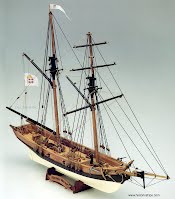 |
| Flying Cloud | The clipper first appeared in the United States around 1820. It is the last stage in the evolution of the sailing ship and it satisfies the demand of the American merchant class, who has realized that the future of trade is on the sea. The American builders create quite a new ship, without imitating schemes and models of the old continent and they obtain immediately such result world shipyards techniques. Flying Cloud, the masterpiece of builder Donald McKay, was built at East Boston ins as to influence the 1851. She acquired a high reputation during the "Gold Rush" in California, making the passage from New York to San Francisco in the record time of 88 days, 22.5 hours, never equaled so far. Length 37" Height 24" Scale 1:96 Advanced Level Double Plank-On-Bulkhead Wood Hull Construction | 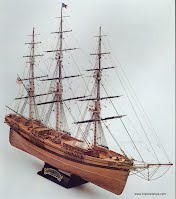 |
| Golden Hind | The Golden Hind took its name from the golden figure appearing on the coat-of-arms of Lord C.C. Hatton’s family, who financed Sir Francis Drake’s circumnavigation of the globe. On the 13th of December 1577 Sir Francis Drake, on board the galleon Golden Hind, together with another four ships. Set out on the most famous voyage of English naval history. After crossing with difficulty the Magellan Straits, owing to the dreadful storms in which two of the ships were wrecked, he moored into the port of Valparaiso. Afterwards he followed the coasts of Chile and Peru plundering Spanish ships and ports and catching an enormous loot. He then went up as far as California, probably trying to discover the so long searched North-West passage. He continued his voyage in the direction of the Moluccas and Java, doubled the Cape of Good Hope and returned to England after three years, completing his voyage around the world. Double Plank on Bulkhead Construction using Limewood and Walnut. Other woods include Boxwood, beech and Tanganyka. 12 Gilded Cannon. Pre-Painted Silk Screened stern and transom. 9 Sheets of Plans and Instructions. Length 20" Height 16" Scale 1:53 Intermediate Level Double Plank-On-Bulkhead Wood Hull Construction | 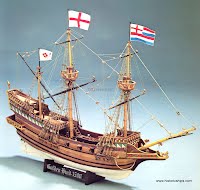 |
| HMS Beagle | H.M.S. Beagle was built around 1817. Class: barque. Length: approx. 28 m. Equipped: 8 guns (before the transformation). Used at first as coasting vessel, it was subsequently equipped for scientific observation which led it across the Atlantic and the Pacific Oceans to the most distant lands. A mizzen-mast was added, so that the ship could be more easily steered along the coral-reefs of the Pacific islands, thus transforming Beagle in a barque. Because of the peaceful aims of the expeditions the guns were removed. 27th December 1831: Beagle sailed from Plymouth, England for a long exploration voyage with one of the most famous scientist on board, Charles Darwin who, through various experiences and acute observations gathered during the voyage elaborated his famous theory of evolution. Length 26" Height 17" Scale 1:64 Intermediate Level Double Plank-On-Bulkhead Wood Hull Construction | 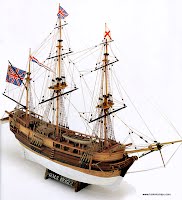 |
| Roter Lowe | The galleon Roter Löwe was built in the Netherlands in the 1597 and was bought in 1601 by the Council of Königsberg on account of the Elector of Brandenburg. It was in service as a vedette-boat n Pillau from 1602 to 1605 under captain Peter Hintze’s command. The sizes of the Roter Löwe are unknown, however, on the ground of the tonnage of 240tons and the construction methods at that time, it was possible to reconstruct a ship having a length of 28 metres from prow to stern and a width of about 8 metres. Equipment: 12 iron guns on the lower deck - 4 guns to launch stone balls on the deck and 2 other for the retreat - 4 culverins. Crew: estimated at 30 hands. Double Plank on Bulkhead Construction using Tanganyka, Mahogany, Maple, Popular, Boxwood and Beech woods. Planking is Limewood and Walnut. Ornamental Fittings are turned Brass, Copper and Steel. Pre-painted Stern Decorations. 12 Sheets of Plans and Instructions. Length 29" Height 122" Scale 1:55 Intermediate Level Double Plank-On-Bulkhead Wood Hull Construction | 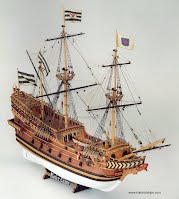 |
| Halifax | Born as a packet-boat, Halifax was purchased in 1768 by the Royal Navy and transformed at Portsmouth England into a typical colonial schooner of the time. These alterations included raising the cabin platform to obtain more storage space below, elevating the bulwarks with openings for the 6 guns and building a new railing with 6 culverins. The outer changes made to the hull as well as to the masting and rigging deeply altered the original aspect. The sources concerning the life of this ship are extremely contradictory. She sailed prevailingly along the American coasts in a rather complex period of the history of this country Length 23-1/2" Height 18-1/2" Scale 1:54 Intermediate Level Double Plank-On-Bulkhead Wood Hull Construction | 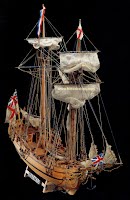 |
| Caracca Atlantica | Three-masted carrack. Length of the hull: approx. 35 m. Height from the top of the mast to the keel: approx. 30 m. The prints of that name and the documents found in the historical archives of the naval museum of Barcelona allowed the reconstruction of the Ship’s plans, which takes its stand between the medieval merchant ship and the galleon, classifiable for its particular structures of the forecastle and quarterdeck among the carracks. Probably around 1519 in took part in an important expedition, which led Fernando Cortez to conquer Mexico. The outer galleries, one of which is a balcony, the apartments under the small quarterdeck, the superstructures of the decks providing the installation of awnings for protection against the sun, clearly indicate that they were employed for the transport of passengers of high class. Characteristics of this ship are the escutcheons at prow, painted with bright colors and having merely a decoration function. Double Plank On Bulkhead Construction using Limewood, Walnut, Mahogany, Popular and other fine woods. Wooden parts are numbered and pre-cut. Fittings are Cast Metal, Brass and pre-finished hardwoods. 12 Cannon, Sails and Cotton Rigging Line. 9 Sheets of Plans. Length 33" Height 25" Scale 1:54 Intermediate Level Double Plank-On-Bulkhead Wood Hull Construction | 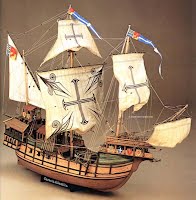 |
| L' Orenoque | L'Orenoque was one of the first French frigates with mixed propulsion, sail-steam, built in 1848. She displaced 2,568 tons. Although she was provided with a mechanical propulsion advanced in concept, she kept the typical masting of the frigates of that time. Scarcely armed, she was mainly used to transport troops. The richness of the superstructures, reproduced with refined performance and faithful scale, the characteristic paddle-wheels and the classic masting give the model a new and original look. Length 33" Height 18" Scale 1:00 Intermediate Level Double Plank-On-Bulkhead Wood Hull Construction | 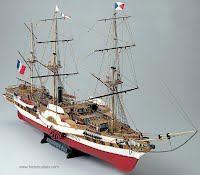 |
| Puritan | Designed by Edward Burgess, the American sloop Puritan was just under 100 feet long. Part of her ballast was fastened to the keel, making her very stable even in high winds. Like many other of her class, she was equipped with a sliding keel. In 1885 under the command of Captain Aubrey Crocker, she defended the America's Cup against the English cutter Ginesta, and won in only two races. Mamoli's 1:50 scale kit reconstructs every detail of the original. Double plan-on-bulkhead construction is made easy by pre-cut poplar keel and frames. The hull is planked with limewood strips for structural strength, then covered with a thin layer of walnut for beauty. Other fine woods in the kit re mahogany, tanganyka, boxwood and beech. Hardwoods, cast metal and brass are used for fittings and hardware. Sail cloth, silk-screened flag and cotton rigging complete the kit. Display stand and nameplate are included as well. Clearly drawn plans and illustrated instructions assist you in sailing to a smooth finish. Length 35" Height 37" Scale 1:50 Intermediate Level Double Plank-On-Bulkhead Wood Hull Construction | 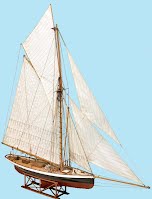 |
| HMS Suprise | Captured by the HMS Inconstant in 1796, the French corvette L'Unite was converted into a 28-gun sixth-rate and renamed HMS Surprise. She carried twenty-four 32-pound carronades on her main deck, eight on her quarter deck and forecastle, plus four 6-pound long guns as chasers. HMS Surprise is the real vessel in Patrick O’Brien’s famous fictional works that tell of Captain Jack Aubrey's adventures, as he sets out on dangerous missions and holds his ground against various enemies. It’s also the star of the recent hit movie, Master & Commander: The Far Side of the World Length 33-1/4" Height 24-1/3" Scale 1:75 Advanced Level Double Plank-on-Bulkhead Construction | 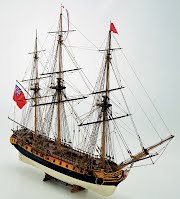 |
| Britannia | The yacht Britannia was built at the request of Edward VII, Prince of Wales. Designed by G.L. Watson, Britannia was the most imposing and important racing yacht of her day. While her lines and construction followed the conventions of the time, her modern rigging and huge sail area reflected new scientific innovations. Kit features double bulkhead construction using pre-cut wooden parts and ready-to-use fittings of brass, gilded cast metal and wood. Cotton sailcloth, rigging line and silk-screened flags are included. Exceptionally detailed plans and illustrated instructions guarantee smooth sailing. Length 22" Height 34.5" Scale 1:64 Intermediate Level Double Plank-On-Bulkhead Wood Hull Construction | 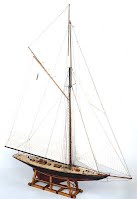 |
| Lexington | The Lexington belonged to a small fleet of merchant ships, which were hastily converted into war ships in Philadelphia in 1775-77 during the war against England. Under captain John Barry's command the Lexington was successfully engaged in battle on April 7th, 1776 against the corvette Edward. During the same year the Lexington was captured by the British frigate Pearl. The crew re-captured the boat again in a daring action and returned it to Baltimore. During the following year the Lexington sailed to France and, together with other ships, took part in various battles in the Bay of Biscay, the English channel and the Irish coast. A number of British ships were captured. On September 20th, 1977 on her return trip from France the Lexington was captured by the English cutter Alert. After a fight of more than three hours the Lexington ran out of ammunition and had to surrender. Length 16.5" Height 15" Scale 1:100 Intermediate Level Double Plank-On-Bulkhead Wood Hull Construction | 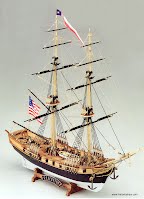 |
| HMS Swift | HMS Swift - the brigantine Swift was built in the colonies in 1776. She was captured by the Royal Navy and sailed under the British flag between 1776 and 1778. Mamoli's double planked kit features 14 burnished metal cannons and 4 swivel guns. Laser cut wooden bulkheads and deck make construction easy. Cast metal fittings include capstan, belaying pins, grudgeons, gunport lids, lifeboat and anchors. Other fittings include hardwood blocks and deadeyes, rigging line, copper chain and brass nails. Gilded metal ornamentation, nameplate and silk-screened flags add life-like authenticity. Full sized plans and illustrated instructions. Length 16-1/2" Height 15-1/2" Scale 1:70 Intermediate Level Double Plank-On-Bulkhead Wood Hull Construction | 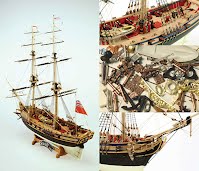 |
| USS Constitution | USS Constitution, known as "Old Ironsides," is a wooden-hulled, three-masted frigate of the United States Navy. Named after the United States Constitution, she is the oldest commissioned ship afloat in the world and is still in service in the US Navy (while HMS Victory is the oldest commissioned ship in the world by three decades, she is permanently drydocked). The Constitution was one of the six original frigates authorized for construction by the Naval Act of 1794. Joshua Humphreys designed them to be the Navy's capital ships and so Constitution and her sisters were larger and more heavily armed than the standard run of frigates from the period. An ideal choice for beginners! Model has plenty of detail without many of the complexities of scale ship modeling. Hull sections are pre-formed poplar plywood, ready for planking. Fittings include walnut deadeyes, blocks, gun carriages and barrels; burnished metal cannon and lots of copper and brass hardware. Silk flag, rigging, water casks and hardwood pedestal are all includes. Six sheets of plans and instructions are easy-to-follow. Length 3" Height 26.5" Scale 1:93 Entry Level Plank-On-Frame Wood Hull Construction |  |
| CSS Alabama | CSS Alabama, the most famous ship of the American Civil War, was a steam and sail sloop-of-war built for the Confederacy in 1862 by John Laird Sons & Co. in Liverpool, England. Under Captain Raphael Seames CSS Alabama engaged Union ships in the North Atlantic and the West Indies doing immense damage to the Union's maritime trade. After leaving Cherbourg, France, where she had docked for repairs, CSS Alabama was assaulted by the USS Kearsarge. Although CSS Alabama fired more rounds than her heavily armored opponent she lost the battle and was sunk off of Cherbourg. Length 27.33" Height 13-2/3" Scale 1:20 Intermediate Level Double Plank-On-Bulkhead Wood Hull Construction | 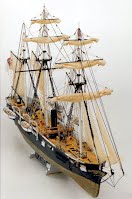 |
| Friesland | Friesland was a second rank vessel with 80 guns built around 1663, part of the great fleet of the United Provinces of Holland, consisting of 1700 units. In 1672, sided by 77 vessels under De Ruyter’s command, on board of the admiral-ship “Zeven Provincen”, it took part in the battle of Solebay with the allied Anglo-French forces. The reconstruction has been carried out on the ground of a reliable Dutch documentation. The model distinguishes itself for the particular refinement of the poop decorations and of the superstructures of the decks. Double Plank on Bulkhead construction, 80 Turned Brass Cannon, Over 50 Gilded Metal Ornaments, Laser Cut Bulkheads and other wooden parts, Cast Zinc Frames to ensure proper alignment of gun ports, Silk Screened Flags, Cotton Rigging Line, Thirteen Sheets of Plans, Step By Step Instructions. Length 31" Height 28" Scale 1:75 Advanced Level Double Plank-On-Bulkhead Wood Hull Construction | 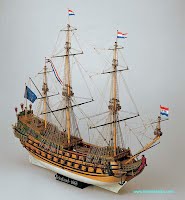 |
| Yacht Mary | When Charles Stuart, the future king of England visited the Netherlands, in 1660, he was impressed with the small, quick pleasure boats the Dutch called "yachts". The Dutch presented him with such a vessel, and he brought the sport of yachting home to England. Charles II loved yachts, and during his reign he owned nearly thirty of them. He named his first yacht after his sister Mary, and the rest after his wives and mistresses. Mamoli's Yacht Mary is double-planked in beech and walnut. Tanganyka and mahogany is used for trim and deck furniture. Keel, frames, decking and display stand are pre-cut. Ready to use fittings are made of hardwood, brass and bronzed metal. The lavish ornamentation supplied with the kit is usually reserved for much larger models. Hull decorations and transom are bronzed metal, and eight cannon mounted on walnut carriages grace her decks. Nine sheets of plans with step-by-step instructions make for easy building. Length 19" Height 19" Scale 1:54 Intermediate Level Double Plank-On-Bulkhead Wood Hull Construction | 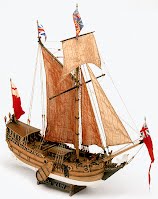 |
| Royal Lewis | The Royal Louis was a 3-deck vessel with 120 guns. Her captain was a Squadron Admiral. She was one of the most powerful first-rank vessels belonging to the French Royal Navy at that time. Our model represents the Royal Louis according to the plans of 1779, when she was Admiral-Ship of the Blue and White Squadron, being part of the American Squadron, also called Earl d' Estaing's. This Mamoli kit is particularly rich in accessories and decorations. Who ever knows how complex are the deck's superstructures of this ship, can easily understand the problems we had to solve in order not to alter the real image. The several molten decorations of the transom are made precious by veneer insertions of precious wood. Thanks to the particular structure of the ship, the reproduction accuracy is such that, through a window of the stern balconies, it is possible to catch a glimpse of the complete inside decks' dressing. Length 43" Height 33" Scale 1:90 Advanced Level Double Plank-On-Bulkhead Wood Hull Construction | 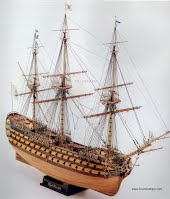 |
| HMS Victory | The first rank vessel H.M.S. Victory, with 104 guns, was launched at Chatham in 1765. It was in service for a long time under the command of famous admirals. Its name was indissolubly tied to Nelson’s in the battle of Trafalgar in 1805. It is the boast of the of the English Navy and is still preserved at Portsmouth. The choice of the scale 1:90 in the reconstruction of such an important model offers the twofold advantage to adopt planning solutions open even to the less experienced modeler and to construct without excessive difficulties a compact model. Large use has been made of precious wood molded according to the form requested by the original. The molten metal port-holes allow a perfect execution of the openings for the guns and it is not necessary to bore the planking. No plastic or plastic wood parts are used. The structure of the quarter-deck is all wood and on it are applied various molten metal decorations. The sheathing of the bottom of the hull with about 3.000 plates reflects the constructive schemes of the original and is of great realistic effect. The observance of the scale is so scrupulous that the quantity of the strips of the planking is the same as the quantity of the boards on the original. Length 44" Height 30" Scale 1:90 Advanced Level Double Plank-On-Bulkhead Wood Hull Construction | 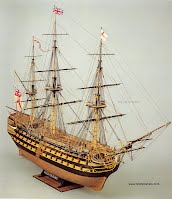 |
| HMS Bounty | Length 24" Height 18" Scale 1:64 Intermediate Level Double Plank-On-Bulkhead Wood Hull Construction | 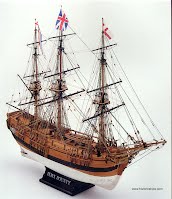 |
| HMS Bounty 1:100 | Mamoli introduces a smaller scale, less complex Bounty. Double plank-on-bulkhead kit features pre-cut wooden parts with lime wood and walnut planking strips. Hardwood and metal fittings include wooden blocks and deadeyes, white metal lifeboat, burnished metal cannon and lots of other details. Two diameters of rigging line and silk-screened flags make for accurate rigging. Three sheets of plans and instructions make building easy. Length 17-1/2" Height 14-3/4" Scale 1:100 Intermediate Level Double Plank-On-Bulkhead Wood Hull Construction | 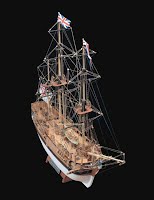 |
| Rattlesnake | The Revolutionary War privateer Rattlesnake was designed in 1779-80 by John Peck, a Boston naval architect. The original Rattlesnake was built in Plymouth, Massachusetts, and in style resembled a miniature frigate, which had a separate quarter deck and forecastle. These features are rather unusual for a privateer. She carried up to 20 guns (probably six and nine pounders), and had a usual complement of 85 men. The original Rattlesnake was commissioned by the Continental Congress of the fledgling United States and helped to win the Revolutionary War by bringing in over $2,000,000 in captured British ships. Privateer action in the North Florida area was intense as Georgia was held by the American Patriots and Florida was held by the British. Little is known of her career except that it was brief. Late in 1781, she was captured by the British frigate Assurance (44 guns) and taken into the Royal Navy as the Commorant (14 guns). Sometime around 1784 it was renamed Rattlesnake after the British discovered they already had a ship named Commorant and soon afterwards was sold out of the British Navy. Little is known as to her disposition from here except that she may have ended up as the French ship Le Tonnant as her lines were exactly the same as Rattlesnakes'. The vessel was unusually fast, and her hull lines were recorded by the British Admiralty after her capture and have come down to us today. Length 28" Height 19" Scale 1:64 Intermediate Level Double Plank-On-Bulkhead Wood Hull Construction | 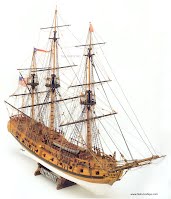 |
| Newport | Used by the Coast Guard, smugglers and pirates. These small craft were very fast and seaworthy, no wonder they were so popular. Length 20-1/5" Height 13-3/4" Scale 1:57 Intermediate Level Plank-On-Bulkhead Wood Hull Construction | 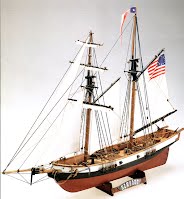 |
| HMS Endeavour | The H.M.S. Endeavour was launched in 1765. She was prepared three years later for a voyage under the command of Captain James Cook. Australia was than discovered and Tahiti and numerous islands sighted. She returned to England in 1771 bringing back all kinds of animals and vegetables unknown in Europe. Captain Cook's 1768-1771 voyage in HMS Endeavour is considered to be of historical importance because she contributed a great wealth of Navigation, Seamanship, Exploration, and Geography to the world's knowledge. During this voyage Captain Cook was the first captain to calculate longitudinal position with greater accuracy using a mathematical formula developed in the 1760s. Cook is also the first to reduce scurvy among his crew, a serious and sometimes fatal result of dietary deficiency on long voyages. Before making history in the service of the British Navy the HMS Endeavour, under the name Earl of Pembroke was a merchant vessel carrying coal from England to Scandinavia. Before setting off in 1768 the HMS Endeavour was drastically refitted, relining her hull, replacing her masts and adding armaments. More recently there is speculation that the HMS Endeavour met her end off the coast of Rhode Island in 1778. The HMS Endeavour was renamed to Lord Sandwich and returned to merchant service transporting coal after her historic voyage in the South Pacific. A ship named Lord Sandwich was intentionally sunk in Newport Harbor in 1778. Length 17" Height 17=4.25" Scale 1:100 Intermediate Level Double Plank-On-Bulkhead Wood Hull Construction | 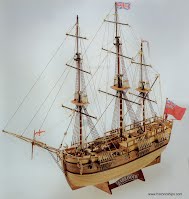 |
| Mayflower | Mayflower offers a lot of kit for the money! Pre-cut wooden keel and frames make plan-on-bulkhead construction easy. Limewood and walnut double planking assure a sturdy and beautiful hull. Pre-colored wooden pieces for quarter-deck and bow ornamentation eliminate intricate painting. Fittings consist of boxwood blocks, walnut deadeyes, wood and metal anchors, cast metal lifeboats and burnished metal gunport lids. Sailcloth, two diameters rigging line, silk-screened flags, metal nameplate and wooden display cradle complete the kit. Seven sheets of detailed plans and instruction booklet help you build an accurate Mayflower ship model. Length 18.75" Height 15.75" Scale 1:70 Intermediate Level Double Plank-On-Bulkhead Wood Hull Construction | 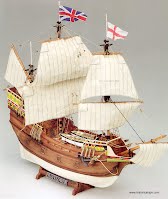 |
| America | The schooner America was designed by George Steers and built in William Brown’s shipyard in 1851. Its name is still the most important and celebrated in the history of world yachting. America under Dick Brown’s command, pilot from New York, set out for England in June 1851 to take part in the regatta which was to be held on the 22nd of August around the isle of Wight, without any compensation for difference in tonnage or rigging. The prize offered was a 100 guinea cup. America carried off an overwhelming victory over the English squadron. When it appeared, America presented remarkable novelties in the form of the hull, above all where the water lines and main section were concerned, the latter pulled back in comparison with the hulls of that time. Besides that it had a low draught, refined lines, a light displacement and a new cut of sails, remarkably thinner and made of a cotton fabric. The 100 guinea cup, become afterwards “America’s Cup”, still gives its name to the most important regatta in the world. Mamoli's Yacht America kit sports pre-cut plywood keel and frames, and pre-shaped mahogany deck. Her hull is planked twice-once in limewood for strength, and again in walnut for a beautiful finish. All fittings are ready to use. Walnut deadeyes and blocks, brass nail, eyelets, rings and chain, and cast metal anchors are only a few of the numerous fittings supplied. Bow ornaments are cast in gilded metal. Canvas sail material and wooden display cradle are also included. Ten sheets of plans are clearly drawn, instructions are easy to follow. Length 27" Height 22" Scale 1:66 Intermediate Level Double Plank-On-Bulkhead Wood Hull Construction | 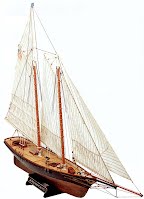 |
| Hunter | The Hunter is a well equipped cutter, built for the British Navy in many, more or less similar copies, in the second half of the seventeenth century, to face the smugglers, who, incidentally, were the first to use this type of ship (it seems that the English shipyards built them in couples: one for the smugglers and one for the Customs…). Of course the Hunter was used also as coast-guard and for military functions of port survey, scout, warning and so on. From these cutters derived, towards the end of the nineteenth century, the sports boats and those meant for the regattas. The model reproduces, to a scale of 1:72, a cutter built towards 1797. It is equipped with 12 guns and several culverins. Length 17-1/2" Height 17-1/2" Scale 1:72 Intermediate Level Plank-On-Bulkhead Wood Hull Construction |  |
| La Gloire | Classic frigate, belonging to the French Navy at the end of the XVIII century. Equipped with 26 12 lb. guns on the battery deck, besides 4 6 lb. guns and 4 carronades on the main deck. La Gloire was planned by the shipbuilding engineer Guignace, and was launched at St. Malo in 1778. This model is the reproduction of the ship during the first year of navigation, with the bottom painted white. One year later, in June 1779, like many other ships, the submerged part of the hull was sheathed with copper plates to protect it from corrosion. Length 33" Height 25" Scale 1:90 Intermediate Level Plank-On-Bulkhead Wood Hull Construction | 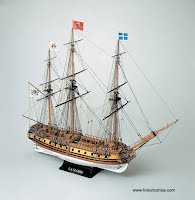 |
| HMS Portsmouth | Length 27-1/2" Height 21-1/2" Scale 1:64 Intermediate Level Double Plank-On-Bulkhead Wood Hull Construction | 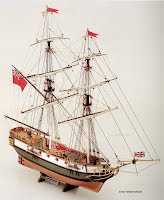 |
| Blue Shadow | Built around 1778, the Blue Shadow is typical of the brigantines used by the American Navy during the Revolutionary War. Double plank-on-bulkhead kit by Mamoli features beech and walnut planking, and pre-cut frames and keel. Fittings are ready-to-use walnut, beech, brass and gilded metal. Twelve bronzed metal cannon mounted on walnut carriage grace for decks. Flags, rigging and display cradle are also included. Step-by-step instructions with nine pages of plans make for trouble-free assembly. Length 27" Height 21" Scale 1:64 Intermediate Level Double Plank-On-Bulkhead Wood Hull Construction | 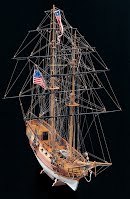 |
| HMS Valiant | HMS VALIANT - British Brigantine Mamoli’s latest addition to its fleet of historic wooden ships is the HMS Valiant. The kit features plank-on-bulkhead construction with double planking, using limewood strips for the first layer and dark walnut for the second. Poplar keel and numbered bulkheads are laser cut for easy assembly. Fittings include ready-to-use wooden blocks, deadeyes and belaying pins, cast metal deadeye strops and chainplate assemblies, blackened metal anchor and miniature brass nails. Ornamentation consists of finely detailed gilded cast metal figurehead and transom pieces. Twelve burnished metal cannon on walnut carriages provide fire power. Silk-screened flags, two diameters of rigging line and cotton sail material add lifelike detail. Four sheets of double-sided plans with clear instructions facilitate construction. Wooden display cradle with metal name plate holds your finished model. Length 27-1/3" Height 22-1/2" Scale 1:66 Intermediate Level Double Plank-On-Bulkhead Wood Hull Construction | 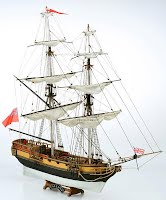 |
| Gretel | During the 18th century the Netherlands was the trading center of Europe, with more ships then rest of the continent combined. Wealthy Dutch merchants built ships intended purely for pleasure, and the quality of Dutch yachts increased with the nation's prosperity. The Gretel is typical of the Dutch pleasure boats of the period. Fast and seaworthy, she and her sisters dotted the Zuider Zee and the canals that criss-crossed the country. Mamoli's kit is double plank-on-bulkhead, with a variety of pre-cut wooden parts in walnut, mahogany, tanganyka, birch and beech. Fittings consist of walnut deadeyes and blocks, gilded metal figurehead, window, door, transom and stern decorations. You'll find five sheets of plans plus detailed assembly instructions. Everything you need is there, including sail material, wooden display cradle and metal nameplate. Length 16-1/2\4" Height 14" Scale 1:54 Entry Level Double Plank-On-Bulkhead Wood Hull Construction | 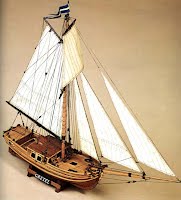 |
| Santa Maria | Even though no original plans exist for the Santa Maria, scholars have determined that Columbus’ flagship was a three-masted carrack with a large foredeck, two square and a lateen rigged sail. Mamoli’s kit combines abundance of detail with ease of construction. From the pre-cut wooden parts to the finely cast gilded metal ornamentation, every component is superb. Double plank-on-bulkhead construction assures a strong and sturdy hull. Dark walnut, lighter beechwood, red mahogany, and yellow boxwood complement each other in color as well as texture. Silk-screened flags, four sizes of rigging and sail material complete a model you'll be proud to display. And you can rely on the plans and instructions to guide you every step of the way. Length 31" Height 22" Scale 1:50 Intermediate Level Double Plank-On-Bulkhead Wood Hull Construction | 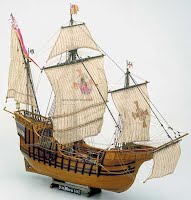 |





